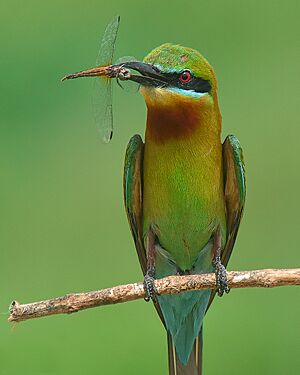Blue-tailed bee-eater facts for kids
Quick facts for kids Blue-tailed bee-eater |
|
|---|---|
 |
|
| Conservation status | |
| Scientific classification | |
| Synonyms | |
|
M. javanicus Horsfield, 1821 |

The blue-tailed bee-eater (Merops philippinus) is a beautiful bird from the bee-eater family. You can find it across South and Southeast Asia. Many of these birds travel long distances, like going on a big trip, depending on the season. They often live and raise their families together in groups, especially near rivers where they dig tunnels in sandy banks for their nests. You'll usually spot them in open areas close to water.
Contents
What Does a Blue-tailed Bee-eater Look Like?
This bird is very colorful and slender. It is mostly green. Its face has a thin blue patch and a black stripe across its eye. Its throat is yellow and brown. The tail is blue, and its beak is black.
Blue-tailed bee-eaters are about 23–26 cm long. This includes two long feathers in the middle of their tail, which can be about two inches longer than the others. Male and female birds look very similar.
What Do They Eat?
Like other bee-eaters, these birds mainly eat flying insects. They especially love bees, wasps, and hornets. They catch these insects in the air while flying out from a perch. They might also hunt over water, like rivers or even near the sea. They seem to eat about the same number of bees and dragonflies.
When they catch an insect, they hit it against their perch. This helps to kill it and break its hard outer shell. This behavior is common in many birds from their group.
How Do They Sound?
When they fly, they often make a rolling, chirping, whistling sound that sounds like "teerp."
How to Tell Them Apart from Similar Birds
The only bird that looks very similar in the same areas is the blue-cheeked bee-eater. However, blue-cheeked bee-eaters prefer drier places. The blue-tailed bee-eater has a blue rump (the lower back) and tail, not green and black. Also, the feathers under its tail are bluish, not green. The blue patch on its cheek is smaller, and the chestnut color on its throat and chest is darker and covers a larger area.
Where Do Blue-tailed Bee-eaters Live and Travel?
Blue-tailed bee-eaters breed in different places across India, Myanmar, and parts of Southeast Asia. In India, they are known to breed in several river valleys. They also nest in the eastern parts of Sri Lanka.
These birds are only in some parts of their range during certain seasons because they migrate. They are known to fly in large groups during the day in places like Tanjung Tuan in Malaysia and Promsri Hill in Thailand. They visit parts of Malaysia and southern India during the winter.
How Do Blue-tailed Bee-eaters Raise Their Young?
In India, they usually breed in April and May. They nest in colonies, meaning many pairs build nests close together. They dig holes in vertical mud banks or even gently sloping sandy ground. They prefer sandy soil and clear mud banks without plants. In Sri Lanka, they have even been seen nesting in sand dunes made by people.
Their nest tunnels can go almost 2 meters deep! They lay about 5 to 7 roundish eggs. Both the mother and father bird help take care of the eggs. The parents also guard their nest to stop other birds of the same species from laying eggs in their nest or to prevent other males from mating with their female.
These birds also feed and rest together in groups. Sometimes, one or two "helpers" might join the breeding pair after the eggs start to hatch. Even though male and female birds look alike to us, male birds usually have longer central tail feathers. Studies also show that healthy males have darker chestnut throats and brighter green body feathers, while females have brighter blue rumps and yellow chins.
Status
The Blue-tailed bee-eater is listed as a species of least concern by the International Union for Conservation of Nature. This means they are not currently in danger of disappearing.
Images for kids
-
At the Powai Lake, India
-
In the Bundala National Park, Sri Lanka
-
In the Yala National Park, Sri Lanka






